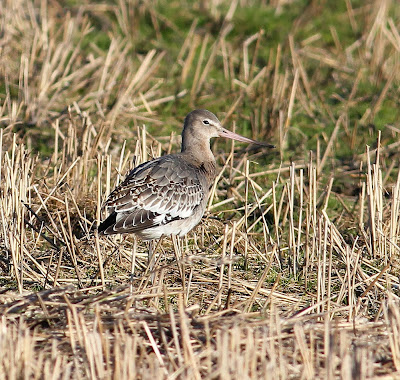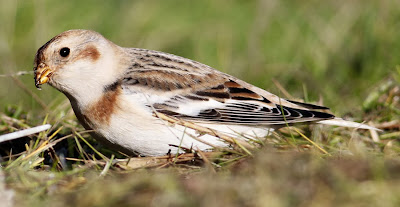This morning’s jaunt out Pilling way provided similar fare to recent days, the exceptions being a build of the Linnet flock and the reappearance of a Curlew Sandpiper.
I stopped at the lane and took in the waders on the stubble, 100+ Black-tailed Godwit, 120+ Lapwings, 4 Curlew, 20 or so Redshanks and a single Snipe. I gave up on the tiny and distant peep which kept disappearing into the troughs of the flooded stubble, and while I thought it was the Curlew Sandpiper I’d last seen on 15th November, I couldn’t be certain.
Black-tailed Godwit
It didn’t take long to find the Peregrine at Fluke Hall as it rocketed along the shore sending everything ahead of it into a panicked frenzy. One of these days I might be sat there with a ready primed camera and get a world beating picture of a Peregrine in full flight- more likely not, so I’ll have to make do with just seeing on an almost daily basis this awe inspiring raptor.
The combination of my approach and the Peregrine put all the crows in the air again, 300+ Jackdaws, 40+ Carrion Crows, 2 Stock Doves and 6 Woodpigeons.
I’ve been missing Wood Pigeons this autumn, counting tiny numbers in comparison to the avalanche of last winter when counts of 10,000 and 20,000 could be easily had on the mossland stubbles, the skies darkened by huge flocks. Last winter the wide scale failure of acorns in Europe brought quite incredible numbers to the UK, now this year seemingly just the opposite. It will be interesting to see what happens when the usual January and February cold weather grips Europe.
Woodpigeon
At the sea wall I was able to count the Linnets moving between the marsh and the stubble, eventually coming to an estimate of 140+. While the Linnets increase, my Skylark numbers now rarely reach double figures, and just 12 today. Two Reed Buntings about the spent maize, together with 4 Meadow Pipit and the usual 40 or so Shelduck coming and going via the wildfowlers pools, plus 30 Whooper Swans feeding on the stubble.
Shelduck
There wasn’t much doing in Fluke Hall, a number of Chaffinch and Goldfinch obvious in the sunny tree tops and a noisy Jay hiding somewhere in the greenery. By 1130 the warm morning sun had sent Tree Sparrows into flurries of noise and activity around nest boxes while near the car a Dunnock was in full song.
On the way back I stopped the car for another look on the flood and clinched the now closer and unimpeded Curlew Sandpiper. A reasonable end to a good morning’s birding.
Curlew Sandpiper - Photo credit: jvverde / Foter.com / CC BY-NC
More soon from Another Bird Blog - keep looking.
Linking today to Anni's Blog and Camera Critters .


















































































